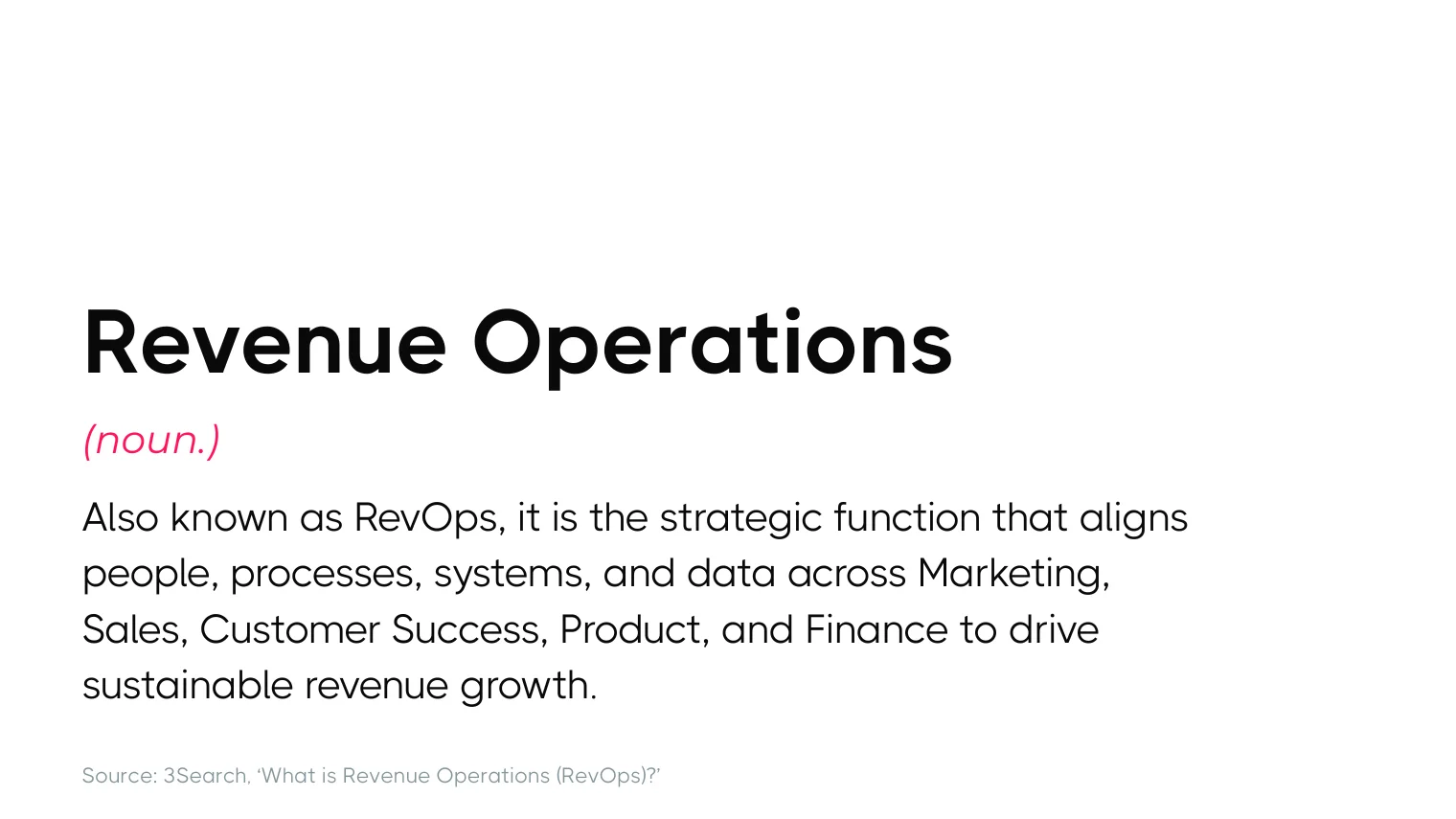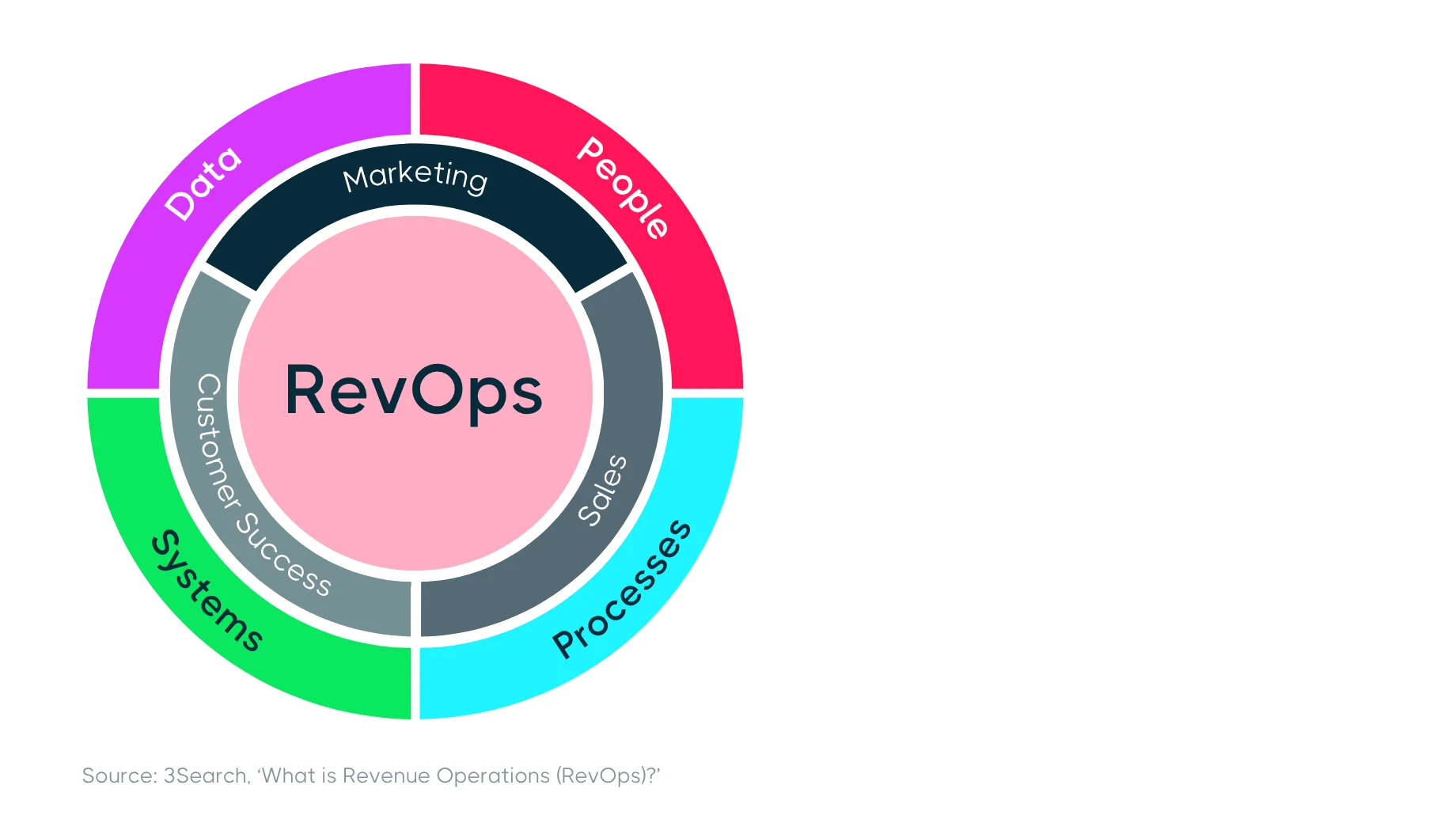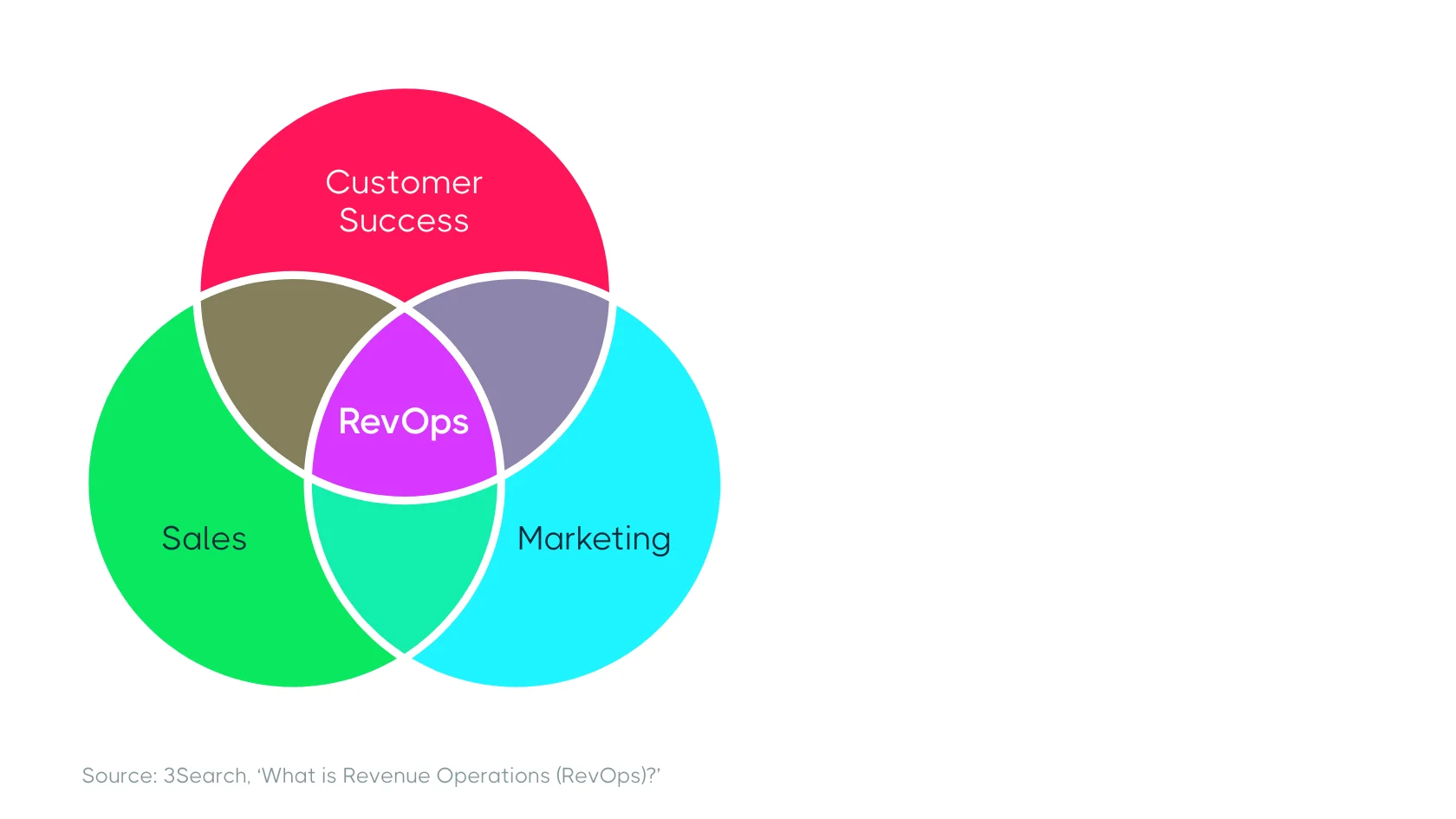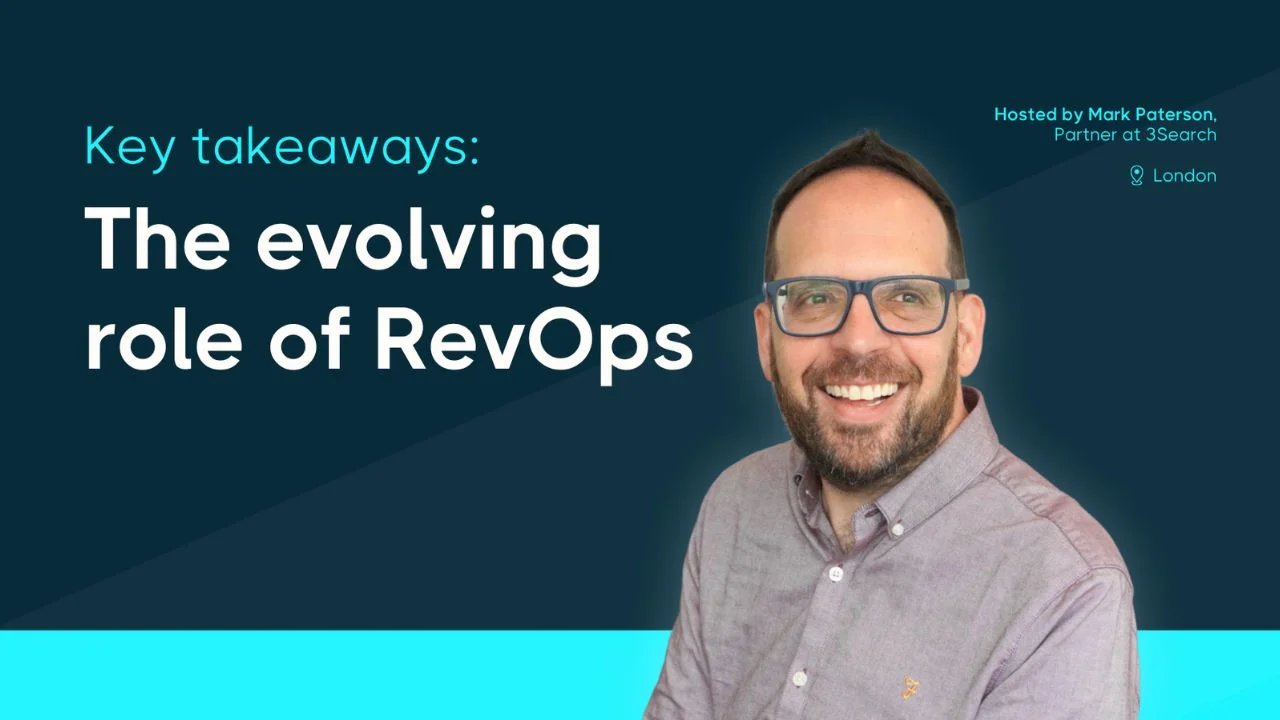While many businesses are already seeing the benefits of Revenue Operations, others still aren’t aware of what it is. To help business leaders understand the function, this article breaks down the definition of RevOps and reveals how it can benefit your revenue generation.
Did you know that you’re probably “doing RevOps” without even knowing it? Born in the SaaS sector, the term ‘Revenue Operations’ is still relatively new. Its growth is not slowing, however. Gartner predict that 75% of the highest-growth companies will adopt a RevOps model by 2026.
But don’t panic if you haven’t started building your team yet. In this article, specialist RevOps Headhunter, Mark Paterson, will be breaking down what RevOps means, who should invest in it and why it matters. We'll even reveal how you can start to build a Revenue Operations team in your organisation.
Jump to:
- What is Revenue Operations?
- How does RevOps work?
- What is the purpose of RevOps?
- Should my business invest in RevOps?
- How can I implement Revenue Operations at my business?
What is RevOps?
Explaining Revenue Operations isn’t easy. No two businesses approach the strategy in the same way. Every RevOps role is unique and reflects the shape, size, pace, and ethos of the business it supports.
This means there’s no single, universal definition. But there’s one thing most fast-growing companies agree on: if you generate revenue, you need RevOps.
RevOps definition
A quick definition: RevOps (Revenue Operations) is the science of sustainable revenue growth.

It’s the function that brings together people, processes, systems, and data across Marketing, Sales, Customer Success, Product, and Finance. Their aim is to build a well-oiled, efficient revenue engine. They remove siloes and ensure that the business is working towards the same, long-term goals.
In many ways, RevOps is ‘elastic’ and should be shaped by the business it supports. This means that each function should be bespoke to fit around a business and be able to expand effectively as the company scales and evolves. This elasticity is crucial to success.
Where did RevOps come from?
While many businesses have unknowingly been “doing RevOps” for years, the term itself only gained traction in the last five years. Emerging from US-based SaaS and software sectors, today it’s gaining traction across a variety of industries nationwide.
Thanks to better CRMs, data analytics and tech, all companies have access to an enormous amount of data. The problem? The data is spread across different business areas. This has created the need for a new profession to collect the data, synthesise it and then visualise it.
High-growth companies are adopting the strategy to ensure their processes are efficient, effective, transparent and always drive revenue growth.
What is the difference between Revenue, Marketing and Sales Operations?
You’re probably wondering how ‘Revenue Operations’ differs from ‘Marketing Operations’ and ‘Sales Operations’.
Sales and Marketing Operations have become subsections of Revenue Operations in the same way that Sales Enablement has.
These two functions typically look reactively at their relative business units. Meanwhile, Revenue Operations will support both functions combined to create a proactive strategic partner to the organisation and ensure both are two parts of the same machine. Too often they are entirely disjointed, and it is this connectivity that unlocks growth.
Marketing Operations
Marketing Operations may be responsible for managing the Marketing Tech stack, the operational aspects of campaign execution, lead management (scoring and routing leads) and process improvement.
Sales Operations
Sales Operations may be responsible for the sales tech stack, process optimisation, forecasting and reporting.
How do they all work together?

Both individual functions are responsible for the data that flows through the funnel, but Revenue Operations now joins the dots.
While Marketing and Sales Operations focus on optimising their respective departmental funnels, Revenue Operations takes a zoomed-out view, connecting the entire revenue engine to ensure seamless handoffs, shared goals, and predictable transparent revenue growth.
How does Revenue Operations work?
RevOps professionals take a holistic view of your revenue engine. They:
- Use data to understand how effectively your teams are working together
- Identify friction, inefficiencies, and gaps in your customer journey
- Build strategies that drive long-term, sustainable growth
In short, Revenue Operations is the glue that holds your Sales, Marketing and Customer Success teams together and ensures they work as one.

Done right, it’s a game-changer. That’s why RevOps Leaders are often described as internal change agents. They bring structure, clarity, and focus to fast-moving businesses.
What tech does RevOps use?
Tech stacks vary, but some common tools include:
- CRM: Salesforce, HubSpot, Dynamics
- Marketing automation: Marketo, Pardot
- Sales enablement: Gong, Salesloft, Outreach
- Revenue intelligence: Clari, InsightSquared, LeanData
- Data visualisation: Looker, Tableau, Power BI
RevOps teams are often the gatekeepers and integrators of these systems. They ensure these systems work together to create a single source of truth. This allows team members from across the business to make truly informed decisions.
What outcomes do RevOps deliver?
There are several benefits of RevOps. The impact they can have on your business is huge. They can:
- Create revenue predictability
- Align commercial teams under shared goals
- Build happier, better-performing teams
- Eliminate costly inefficiencies
- Drive profitability and scalability
Done well, Revenue Operations can increase ROI on digital campaigns by up to 100%, accelerate growth, and raise company valuation - all without a corresponding rise in costs.
What does a RevOps Leader try to achieve?
At the heart of the strategy are Directors of Revenue Operations. While no two leadership roles look the same, all RevOps Leaders share common priorities. They aim to:
- Establish a RevOps function from scratch
- Build or refine the Go-To-Market strategy
- Scale commercial operations
- Forecast reliability and revenue modelling
- Lead CRM adoption and audit data integrity
- Support underperformance and talent enablement
- Eliminate revenue leakage
What metrics do they track?
With RevOps touching every part of your revenue engine, you can easily see how successful yours is. There are a number of metrics you can track, including:
- Business profitability
- Sales growth
- Digital marketing ROI
- Revenue growth
- GTM expense reduction
- Stock performance
- Customer retention
- Sales win rate
- Employee productivity
Some will be more relevant than others depending on your business model. For instance, a direct-to-consumer brand might choose to monitor stock performance levels. Whilst a B2B SaaS organisation might focus on their customer retention rates.
According to research from Rattle, the most common metrics for RevOps teams to track are:
- Revenue growth
- Operational efficiency
- Sales cycle improvements
Should you invest in RevOps?
When to invest in Revenue Operations
Every company will already be actioning some parts of Revenue Operations, but having a formal strategy that is managed by a team often comes later. It is often triggered by scale, acquisition or investment.
Why? Because as companies scale, systems grow in complexity. Growing businesses will see
- Every employee using their favourite SaaS app
- Every manager maintaining their own spreadsheet
- Every team building their own process
You might think this isn’t an issue, but this usually leads to miscommunication and efficiency suffers.
How do you build a RevOps team?
There are three approaches to building your RevOps strategy:
- Build a unit using internal talent
- Deploy an external advisory firm to support
- Hire a leader to build and lead a formal Revenue Operations team
What’s the future of Revenue Operations?
We’re only at the beginning. While tech companies led the charge, businesses in every industry are now building formal functions. Plus, artificial intelligence and automation tools are already taking it to the next level, reshaping workflows from lead scoring to forecasting.
But at its heart, RevOps will always be about people, process, and performance.
Ready to start building your team?
Get in touch with our specialist recruitment consultants to find out more about the function and how we can help your growth.



